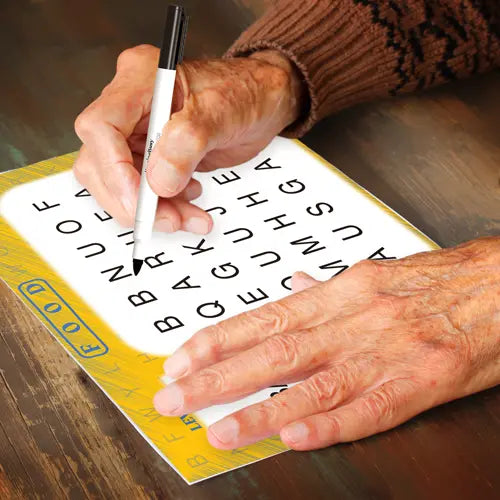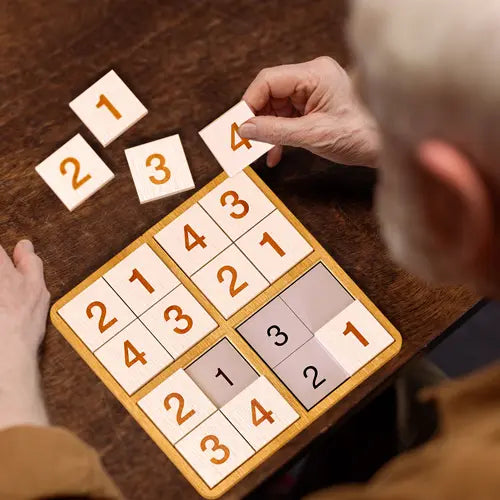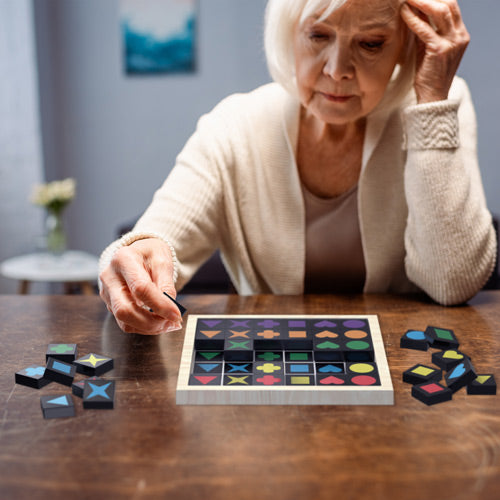
We recently received a note from a recreation director at a long term care facility looking for some help getting their Montessori program going. This is a common problem and we thought that we would share the information because it may help others in the same situation, and some may have ideas to offer. If you have any ideas, or situations that you would like to discuss, send us a note.
About 75% of the residents in the 60 bed facility where Jennifer works have some sort of dementia but there is no dementia secure unit. Jennifer received DementiAbility training several years ago but is still struggling with the Montessori dementia care concept and its implementation. She does one on one activities for patients such as folding laundry and looking at books, as well as reading groups with some of the residents, but realizes that there’s more. There is a core group of 15 or so residents who participate in virtually every program that she offers, and she also has two dementia patients who need special attention. One won’t participate in any activity and the other just wants to walk and walk. As is often the case, Jennifer’s resources are stretched thin between providing programming for the residents and her administrative duties.
Here is Donna’s response to try to help Jennifer:
First off, I will say that I typically find that it is more of a challenge to focus on the residents with the highest needs when there isn’t a special care unit. The greatest success is typically achieved in homes with a 12-30 bed demen tia unit where we can establish a regular activity schedule that compliments the energy and needs of the residents throughout the day. The logistics are more challenging when the population is mixed. There is also the added challenge of the core group of participants. It is difficult to get them to understand that when you offer small group programming designed to engage residents with dementia in meaningful activity, the program is not for them because it will not be effective when it is open for all to attend.
The recent articles on dementia, Applying Montessori Principles for Dementia to Group Activities and The Benefits of Small Group Activities for Dementia Patients, provide more information.
Bingo is one of the best examples that I use when I am trying to explain my vision of a Montessori approach to dementia care. When bingo is offered in a large group setting there are many potential barriers that prevent a resident with dementia from achieving two of the primary Montessori principles: success and independence. Some of the barriers include visual and/or hearing impairment, dexterity issues, and reaction time, not to mention difficulties in complex attention and executive function related to dementia. If we instead offer dementia specific modified bingo at different times of the day, those bingo enthusiasts can be offered a program that is tailored to their needs.
My suggestion is to
- Offer simplified bingo at 11am (the ideal time for cognitive stimulation for residents with dementia) for the appropriate residents. Use a 3 x 3 grid rather than 5 x 5 and experiment with pictures and words rather than just numbers. You may also want to try Card Bingo.
- Offer the most challenging bingo in the evening for the residents who are most independent – fast paced, no limit to the number of cards they play etc., maybe even work towards having them run it on their own (like they might have a regular card group in the evening)
- If you have a regular 2pm bingo game as is the case in many facilities, it could be scaled back to a smaller room and residents that weren’t appropriate for the other two groups would attend (this might speed up the game, reduce some of the noise and distraction).
In keeping with the Montessori principles for dementia, you should also
- Take away the emphasis on winning, rewards and prizes and instead emphasize the therapeutic benefits of the program,
- Increase the social aspect of the program- encourage the participants to greet each other at the start and end of the session, for example
- Establish roles for specific residents such as passing out the markers, greeting people at the door, collecting the cards and markers when the game is over
The idea is that by incorporating more small group programming you can spread your thin resources out to provide the opportunity to engage more residents effectively with the same time requirement. As Jitka Zgola says in her book Care that Works
“A one-hour group program that involves thirty people may be done every day. It takes a good half-hour to bring everyone together. With such a large number, the facilitator must give individual attention to keep members attentive. Each person may get two minutes of attention.
A small group program offered to six compatible persons twice weekly for a half-hour requires the same amount of staff time and offers each member a full hour per week of meaningful interaction”
Regarding your two residents – obviously I can’t offer any real insights without spending some time with them, but I can offer some general suggestions. One concept to consider is that limited attention span and ability self-initiate are resulting in boredom, which can be one of the contributing factors to their restlessness. Experiment with different materials to engage these residents for 2 minutes and then 5 minutes and then longer periods. Some things to try might be to have them
- separate two decks of cards (by the pattern on the back of the cards)
- sort mixed colors of poker chips, putting chips of the same color in labeled bags
- put lids on plastic containers for some purpose
- put individual jam or tea packages into a container organized by type
- put the puzzle pieces away for a completed sequenced puzzle – sorting the pieces into the bag label that matches the dot on the back of the piece
- connect pieces of conduit together
- find the keys that open a selection of padlocks
- put cutlery from a basket into a cutlery tray
Once you find a few things that fit the bill, make those materials available and accessible and let everyone in the circle of care know how to offer them to the resident effectively. When the resident is alert and before they become restless, if they are offered one of these activities they benefit while they are engaged in doing the activity and the positive effect of that engagement has been shown to last 45 minutes to an hour afterwards. Specific ideas are not easy to suggest without spending time with the residents, but I can say that when I am starting fresh, the first program I implement are “Chores” as described in our Chore Style Activities article.
I hope this helps.
For a continuation of the discussion, see our article "The Mathematics of Time - Allocating a Limited Resource".




